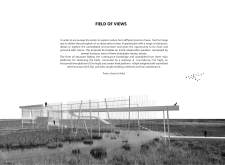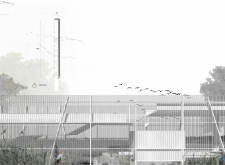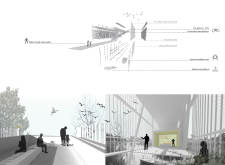5 key facts about this project
## Overview
Field of Views is an observation pavilion designed to facilitate exploration and interaction with the natural environment through multiple vantage points. Located in a landscape conducive to birdwatching, the structure aims to enhance visitors' engagement with the surrounding ecosystem, offering a venue for immersive experiences in nature.
## Design Structure and Configuration
### Form and Layout
The pavilion features three distinct platforms that provide varied viewing experiences:
1. **Top Balcony**: Located 7 meters high, this platform offers panoramic vistas.
2. **Horizontal View Platform**: At a height of 4.5 meters, this section allows for eye-level observations.
3. **Water Level Platform**: This ground-level area integrates with natural water features, promoting close interactions with local wildlife.
A gently sloping staircase connects these platforms, encouraging movement and accessibility throughout the structure. The overall design emphasizes continuity, extending elegantly across the landscape.
### Materiality
The choice of materials is integral to the pavilion's function and aesthetics:
- **Lightweight Steel**: Employed for the primary structural elements, ensuring durability with minimal maintenance requirements.
- **Perforated Steel Mesh Panels**: Serve as protective barriers that facilitate visibility and light transmission while contributing to the structure's visual delicacy.
- **Steel Profile Structure**: Enhances the framework's rigidity and supports the minimalist architectural language of the pavilion.
## Spatial Experience
The spatial organization promotes a rich visitor experience through strategically placed observation platforms and sightlines. This arrangement invites users to engage with their environment by perceiving, hearing, and feeling natural elements from varying heights and distances.
### Interactivity
Field of Views incorporates features that foster interactivity, allowing visitors to navigate between spaces and engage dynamically with wildlife. This design aspect not only enhances educational and recreational opportunities but also encourages a personal connection to the natural world.
## Environmental Integration
The pavilion's elevation and design elements ensure unobstructed views of local wildlife, effectively integrating it with the surrounding landscape characterized by fields and water bodies. This approach reinforces the relationship between the built environment and the ecological context.






















































